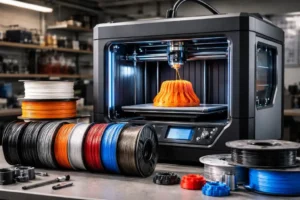
- +91 8055996347
- info@3dreality.in
- Chapru nagar square, CA road, Nagpur, Maharashtra-440008

Innovation in the medical field often begins with a prototype. Whether it’s a surgical instrument, implant, or diagnostic tool, prototyping is the critical first step in creating life-saving medical devices. But traditional prototyping methods can be slow, costly, and inflexible—delaying product development and increasing expenses.
That’s where 3D printing steps in. As a cutting-edge manufacturing solution, 3D printing allows healthcare innovators to design, test, and iterate medical device prototypes faster than ever before. This technology is revolutionizing how new medical devices are developed and brought to market—making it easier, more affordable, and more personalized.
Rapid prototyping refers to the fast fabrication of a physical part or model using computer-aided design (CAD). In the medical sector, it’s used to create prototypes of devices that can be tested for form, fit, and function before full-scale production.
Medical rapid prototyping can be used for:
Prototyping is essential not just for design validation, but also for clinical testing, user feedback, and compliance with regulatory standards.
Time is crucial in healthcare innovation. 3D printing dramatically reduces the development timeline by enabling same-day or next-day prototype production. Design iterations that once took weeks can now be completed in hours. This fast turnaround helps medical startups and R&D teams stay ahead in competitive markets.
Traditional manufacturing requires costly tooling, molds, and setup—even for a single prototype. 3D printing eliminates these initial expenses, making it far more economical, especially for small-batch or one-off designs. You only pay for the material used and the printing process—no extra tooling needed.
Every patient is unique, and so are their medical needs. With 3D printing, personalized medical devices can be designed quickly and accurately. Whether it’s a prosthetic limb tailored to a patient’s anatomy or a surgical guide fitted to an individual’s bone structure, customization becomes easy and affordable.
Unlike traditional methods, 3D printing allows for the creation of complex shapes and internal structures that would be impossible to achieve with CNC or molding. This freedom gives engineers the flexibility to innovate and push boundaries in device design.
Prototypes produced through 3D printing aren’t just visual—they can be functional. You can test the mechanical properties, ergonomics, and usability of a device in real-world settings before committing to mass production. This allows for better validation and fewer errors down the line.
Today’s 3D printers can use a wide range of bio-compatible materials, including flexible, rigid, and even sterilizable resins. These materials closely mimic final production materials, giving you more accurate testing results during the prototype phase.
3D printing is an additive process, meaning it builds objects layer by layer, using only the necessary material. This drastically reduces waste compared to subtractive manufacturing processes like milling or machining.
If you’re a healthcare professional, researcher, or medical startup in Nagpur looking to bring your device idea to life, 3D Reality is your local partner in innovation.
We offer:
We collaborate closely with our clients to ensure that every prototype meets both technical and clinical standards.
3D printing is unlocking incredible possibilities in the medical field—especially when it comes to prototyping. It makes the development process faster, more flexible, and more affordable, empowering healthcare innovators to bring life-saving solutions to market quicker than ever before.
If you’re ready to prototype your next medical device or want to explore how 3D printing can support your healthcare innovation, connect with us at 3D Reality, Nagpur.